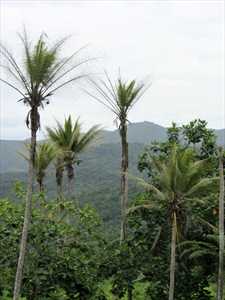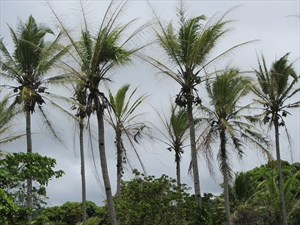Coconut stick insect
Pacific Pests, Pathogens and Weeds - Online edition
Pacific Pests, Pathogens & Weeds
Coconut stick insect (102)
Graeffea crouanii. It is a member of the Phasmatidae.
It is recorded from American Samoa, Cook Islands, Fiji, French Polynesia, Kiribati, New Caledonia, Niue, Samoa, Tokelau, Tonga, Tuvalu, Vanuatu, and Wallis & Futuna.
Coconut, sago palm, Pandanus and some wild palms.
The adults (Photos 1&2) strip the leaflets, mostly from the older leaves, with only the midribs remaining (Photos 3-5).
Eggs are laid in the crown of the palms, and fall into the base of the leaves, or to the ground where they remain in leaf litter and among weeds. They hatch in about 12-16 weeks. The nymphs, which are tiny versions of the adults, make their way up the trunks if they hatched on the ground, or from the leaf axils, to feed on the leaflets. There are five and six moults for males and females, respectively. From egg to adult is about 3.5 months for males and 4 months for females. Only males have functional wings and can fly (Photo 1). Both adults and nymphs feed at night.
Damage is worse on palms that are over 25 m tall. In Fiji and Samoa, defoliation sometimes occurs over several hundred hectares, but outbreaks only occur occasionally. In Fiji, defoliation, crop loss and death of palms have been reported.
Look for leaflets eaten at the margins; look for large insects with characteristic shape - long, thin bodies and very long legs; the females are green up to 120 mm long and 6 mm wide, and the males are brown and 70 mm long and 3 mm wide.
NATURAL ENEMIES
Chickens readily eat the stick insects, as do myna birds, but not enough to control populations. Skinks eat the eggs. Ants and preying mantids are said to provide some control, but they are probably not effective predators.
Parasitic wasps, especially Paranastatus verticalis and Paranastatus nigriscutellatus, have been recorded from eggs in Fiji and Tonga. Paranastatus verticalis has been bred occasionally in Fiji to control high populations of Graeffea. Both species were imported into Samoa from Fiji and became established. Paranastatus verticalis was released into Tonga in 1977 and became established there.
CULTURAL CONTROL
Cultural practices are important in preventing outbreaks of this insect. Do the following:
- Burn fronds under the palms on still days causing the stick insects to fall to the ground, where they can be eaten by chickens or killed by hand. Note, although effective, the fires damage the coconut palms and the method is no longer used in most countries.
- Use horticultural glue bands around the trunks. The glue is a non-drying sticky substance made from natural gum resins, vegetable oil and wax that prevents crawling nymphs from reaching the coconut leaves. One such product is called "Tanglefoot".
- Control weeds under coconuts. Doing so exposes the eggs to the sun, and eggs and young nymphs to chickens and ants, particularly the big-headed ant, Pheidole megacephala.
- Plant cocoa beneath coconuts. Unpublished accounts in Samoa suggest that death of nymphs is high as they mistakenly climbing cocoa trees rather than coconut palms, and starve.
RESISTANT VARIETIES
None known.
CHEMICAL CONTROL
Use of insecticides on young palms is feasible, but applications on mature palms are not possible from the ground. If insecticides are necessary, use a synthetic pyrethroid.
Previously, bands of insecticide with long residual life, such as dieldrin, were painted on the trunks; however, such chemicals are no longer recommended, and in many cases banned under international treaties. Similarly, trunk injections using systemic chemicals, such as monocrotophos and acephate, were once used routinely in Fiji, and were tested in Samoa. They were effective, but had the disadvantage in allowing the entry of fungal pathogens that may kill the palm. Note, monocrotophos is a highly toxic organophosphate and is banned in many countries.
____________________
When using a pesticide, always wear protective clothing and follow the instructions on the product label, such as dosage, timing of application, and pre-harvest interval. Recommendations will vary with the crop and system of cultivation. Expert advice on the most appropriate pesticides to use should always be sought from local agricultural authorities.
AUTHOR Grahame Jackson
Information from Waterhouse DF, Norris KR (1987) Graeffea crouanii (Le Guillou). Biological Control Pacific Prospects. Inkata Press. Assistance also provided by Wilco Liebregts, Eco-Consult Pacific, Fiji. Photo 1 Gerald McCormack, Cook Islands Biodiversity & Natural Heritage. (http://cookislands.bishopmuseum.org/). Photos 2-5 Richard Markham, ACIAR, Canberra.
Produced with support from the Australian Centre for International Agricultural Research under project PC/2010/090: Strengthening integrated crop management research in the Pacific Islands in support of sustainable intensification of high-value crop production, implemented by the University of Queensland and the Secretariat of the Pacific Community.








